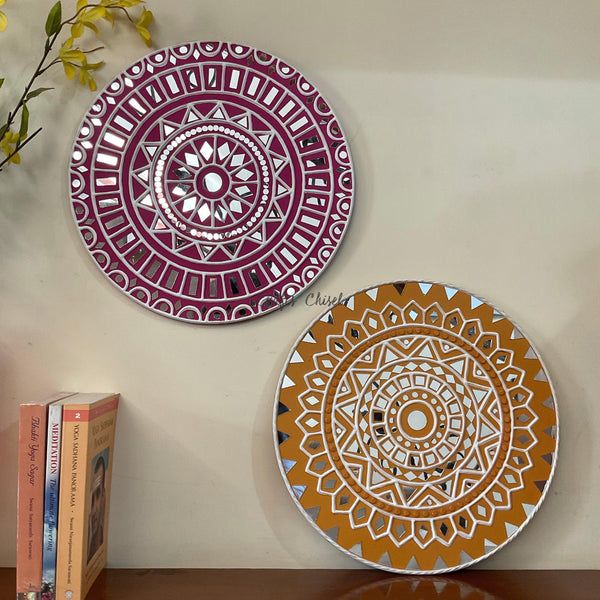Kutch Lippan art (Lippan Kaam or Chhittar Kaam as it is more famously called) is a kind of mural craft native to the Rann of the Kutch region of Gujarat. The craft in essence is mud-relief work that involves mirrors, done on the walls of the mud houses in the region. It is an important art form and is quite popular. A dough is prepared from animal dung which is then spread on walls, upon which designs are created. The people of the Kumbhar community are generally considered to have originated the art form, besides whom it has been practiced by Rabari, Marwada Harijan, and Mutwa communities.
History of the Art
It is unclear exactly when Lippan Kaam began to be made. Maybe it started with the migration of the Rabari and Mutwa communities and their sub-tribes to the Kutch region from Sindh some five hundred to seven hundred years ago, while Harijans migrated from Marwada. It is believed that the expertise in mud and clay work of Kumbhars was transferred to these communities as they found larger canvas-like interiors or exteriors of mud huts. The Mutwa people on the other hand are known for their distinct embroidery work even though their main livelihood is dependent on livestock.
Techniques and Themes
For Kutch Lippan art, animal dung is used along with mud or clay fetched from the lakes present in the Kutch region. They are mixed in equal measure and formed into a dough. Once ready, the canvas surface (generally walls in this case) is made moist so that mud sticks. A border is created which acts like a frame for the artwork. Cylindrical strips are rolled out of the dough and then used on the surface to create patterns. Back in the day, large mirrors were crushed using stones and arranged beautifully to be used as designs. Mirrors of various shapes called “aabhla” are available these days. Relief work – a mixture of mud and dung – is laid around these designs. Upon drying, white clay or sand is used to coat the artwork.
Motifs used in the artwork are from everyday life: animals and birds such as camels, elephants, and peacocks are present, as are mango trees and temples. Each community has its own characteristic motifs – those of the Rabari community, for example, are women holding pots or them having buttermilk churned. The Rabaris make use of a lot of mirrors. Motifs of the Harijan community are taken from embroidery and geometric patterns, while those of the Mutwas are thin lines and other geometric shapes. This recurring use of geometric motifs is a reflection of how simple the tradition is.
Materials and colours used
The main materials in Lippan Kaam are animal dung, mud, and clay. There have been changes in its preparation in recent times. Mirrors shaped in circular, triangular, or diamond-shaped patterns are generally used. Wooden boards composed of medium-density fibreboard (MDF) are used on the surfaces. This makes the artwork portable. The dough now is a mixture of glue mixed in with chalk powder, sawdust, and mud.
Although traditionally white, the patterns and designs of Kutch Lippan art these days are also made in various shades of red, green, white, and also blue. To enhance its appeal, colours that are washable and waterproof are often used.
Prominent Artists
Kutch Lippan art continues to be practiced to this day. Artists like Rachana Giridharlal Rathod and Neethalal Rathod – a mother and daughter duo – help keep the tradition alive while incorporating new techniques into their work. They run a mud-mirror-works company which has been receiving government support of late.
Also, another notable artist hailing from Bhuj is Irfan. Having been in the field for fourteen years, his work is marked by a special preparation of the dough and has drawn clients from places as far apart as Bangalore, Ahmedabad, and Mumbai.
The Current Scenario of the Art
Lippan Kaam is now being recognized as a prominent art form. In 2005, the Rann Utsav was launched which boosted tourism, thereby giving a livelihood to these artists. The art has been attracting brands and NGOs such as the Dastakari Haat Samiti which holds exhibitions once a year. There is commissioned work available in residential areas and hotels. With the coming of the internet, workshops have sprung up online which is also doing its part in giving the artists a wider reach. These stand testament to how important and precious Kutch Lippan art is to the country’s heritage.
– Anubhab Biswas
(Content Writer at ArtsOfIndia.in)
Picture Source: Pinterest





